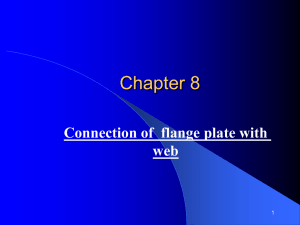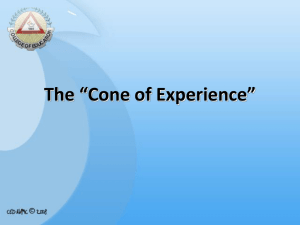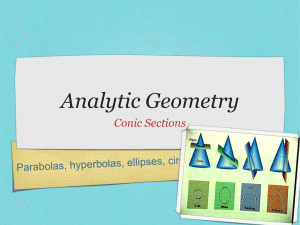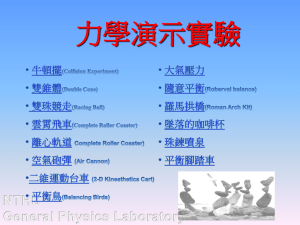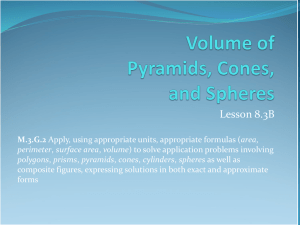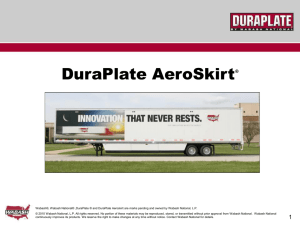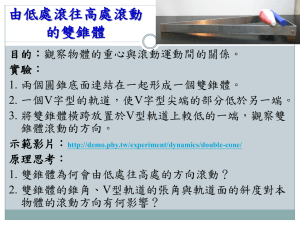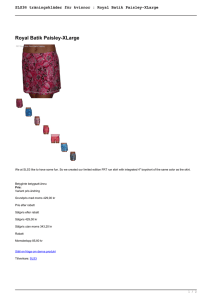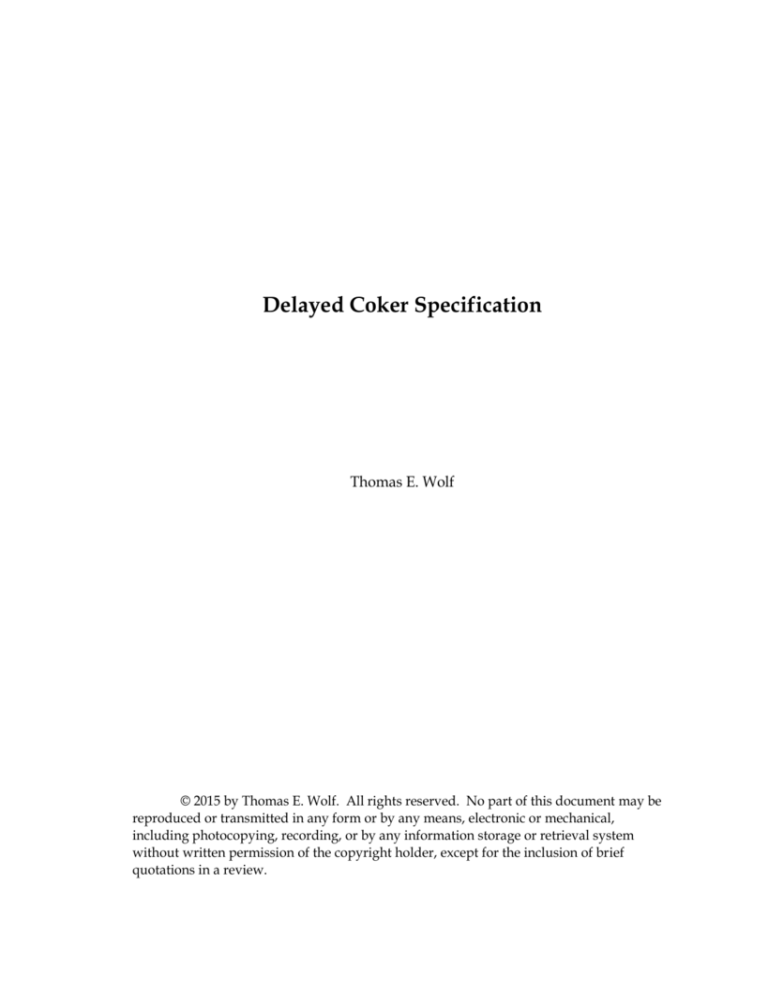
Delayed Coker Specification
Thomas E. Wolf
© 2015 by Thomas E. Wolf. All rights reserved. No part of this document may be
reproduced or transmitted in any form or by any means, electronic or mechanical,
including photocopying, recording, or by any information storage or retrieval system
without written permission of the copyright holder, except for the inclusion of brief
quotations in a review.
COKE DRUM SPECIFICATION
Contents
1.
General
2.
Codes and Standards
3.
Dimensions and Quantities
4.
Operating Conditions
5.
Design Conditions
6.
Maximum Allowable Working Pressure
7.
Hydrotest Pressure
8.
Weights
9.
Materials
10. Nozzles and Appurtenances
11. Fabrication
12. Welding
13. Post Weld Heat Treatment
14. Inspection and Testing
15. Surface Preparation and Painting
16. Insulation and Fireproofing
17. Shipping and Lifting
18. Order of Precedence
19. Reference Drawings and Standards
PLEASE NOTE – THIS IS COPYRIGHTED MATERIAL, IT IS PROVIDED FOR
YOUR INFORMATION. PLEASE FEEL TO USE IT, BUT PLEASE DO NOT
ABUSE THE COPYRIGHT.
1. GENERAL
1.1. Revision Number: ___________ Revision Date: ______________________
1.2. By: _____________ Checked: ____________ Approved: ____________
1.3. Client: ___________________________________________________________
1.4. Project Name: ____________________________________________________
1.5. Project Location: __________________________________________________
1.6. Project Number: __________________________________________________
1.7. Item Numbers: ___________________________________________________
1.8. Name: ___________________________________________________________
1.9. Service: __________________________________________________________
1.10.
Request For Quotation Number: ______________________________
1.11.
Purchase Order Number: ____________________________________
1.12.
Owner/Engineer Contact: ____________________________________
1.13.
Owner/Engineer Contact Information:
o
______________________________________________
o
______________________________________________
o
______________________________________________
1.14.
Supplier/Fabricator: _________________________________________
1.15.
Supplier/Fabricator Contact: _________________________________
1.16.
Supplier/Fabricator Contact Information:
o
______________________________________________
o
______________________________________________
o
______________________________________________
1.17.
Shop Location: _____________________________________________
1.18.
Shop Order Number: ________________________________________
1.19.
____________________________________________________________
1.20.
____________________________________________________________
Page 3 of 39
2. CODES AND STANDARDS
2.1. Design Code
2.1.1.
These vessels to be designed and fabricated in accordance with
ASME Code Section VIII Division 1, Section II, Section V, and
Section IX and latest Addendums.
2.1.2. Vessels to be code stamped: YES
2.1.3. Vessels require National Board Registration: YES ____NO ____
2.2. Wind Design
______________________________________________________________
2.3. Seismic Design
______________________________________________________________
2.4. ______________________________________________________________
2.5. Additional Specifications and Standards
2.5.1. __________________________________________________________
2.5.2. __________________________________________________________
2.5.3. __________________________________________________________
3. DIMENSIONS AND QUANTITIES
3.1. Dimensions List/No Duplication - All dimensions and quantities are to be
listed in this section below and not to be duplicated elsewhere within this
document. All revisions to dimensions and quantities are to be listed in
this section below and not to be duplicated elsewhere within this
document. Only dimensions and quantities are to be included in this
section; that is, all notes, clarifications, requirements, etc. are to be
included in subsequent sections.
3.2. Reference Dimensions and Quantities – All referenced dimensions,
lengths, diameters, radii, angles, quantities, etc. required are in accordance
with the attached sketches, see paragraphs 3.6 through 3.13, below.
3.3. Origination and Verification – The Owner/Engineer specifies certain
dimensions and quantities and the Supplier/Fabricator verifies the
dimensions and quantities are per Code and specification. The
Supplier/Fabricator specifies certain other dimensions and quantities and
the Owner/Engineer verifies the dimensions and quantities are acceptable
and per requirements.
3.4. Dimensional System –
o
Customary Units, English (feet, inches, etc.) or
o
SI Units, Metric (meters, millimeters, etc.)
3.5. Input – Quantities and Dimensional Data (for multiple drums, Quantities
and Dimensional Data may vary).
3.5.1. Quantities
X1 - __________ Number of Drums
X2 –
below
Duration of coking cycle (see P-T Diagram, Para 4.4)
X3 - __________ Number of years expected before first shutdown due to
major repairs
X4 - __________ Number of anchor bolts
X5 - __________ Number of skirt slots
X6 - __________ _________________________________________________
X7 - __________ _________________________________________________
3.5.2. Diameters
D1 - __________ Drum inside diameter
D2 - __________ Inside base plate diameter
D3 - __________ Inside skirt diameter
D4 - __________ Outside skirt diameter
D5 - __________ Anchor bolt circle diameter
D6 - __________ Outside base plate diameter
D7 - __________ Skirt slot hole diameter, top and bottom of slot
Page 5 of 39
D8 - __________ Anchor bolt diameter
D9 - __________ Top anchor bolt chair plate hole diameter
D10 - __________ _______________________________________________
D11 - __________ _______________________________________________
3.5.3. Lengths
L1 - __________ Overall Length
L2 - __________ Tangent to Tangent Length
L3 - __________ Top tangent line to top nozzles flange face length
L4 - __________ Bottom tangent line to bottom nozzle flange face, M1
L5 - __________ Bottom tangent line to bottom of base plate length
L6 - __________ Bottom tangent line to centerline of feed nozzle, N1
L7 - __________ Btm tangent line to centerline of level instrument LV1
L8 - __________ Btm tangent line to centerline of level instrument LV2
L9 - __________ Btm tangent line to centerline of level instruments LV3
and LV4
L10 – _________ Btm tangent line to nominal top of coke during coking
cycle
L11 - _________ Anchor bolt length above top of concrete
L12 - _________ Baseplate anchor bolt slotted hole length
L13 - _________ Baseplate anchor bolt slotted hole width
L14 - _________ Height of anchor bolt chair plate
L15 - _________ Top of Skirt to btm tangent line (for overlapping skirt)
L16 - _________ Skirt slot distance to bottom tangent line
L17 - _________ Skirt slot length
L18 - _________ Skirt slot width
L19 - _________ Hot box distance to bottom tangent line
L20 - _________ Nozzle M1 face of flange to weld bevel length
L21 - _________ Cone, lower straight flange length
L22 - _________ Cone, upper straight flange length
L23 - _________ _________________________________________________
L24 - _________ _________________________________________________
3.5.4. Radii
R1 - __________ N1 nozzle flange face to centerline of drum radius
R2 - __________ N2 nozzle centerline to centerline of drum radius
R3 - __________ N3 nozzle centerline to centerline of drum radius
R4 - __________ N4 nozzle centerline to centerline of drum radius
R5 - __________ N5 nozzle centerline to centerline of drum radius
R6 - __________ N6 nozzle centerline to centerline of drum radius
R7 - __________ Cone, inside top knuckle radius, IKRT
R8 - __________ Cone, outside bottom knuckle radius, OKRB
R9 - __________ Inside (weld) junction radius, see Para. 3.9
R10 - _________ _________________________________________________
R11 - _________ _________________________________________________
3.5.5. Angles
Θ - __________ Cone angle
Θ1 - __________ N1 nozzle orientation
Θ2 - __________ N2 nozzle orientation
Θ3 - __________ N3 nozzle orientation
Θ4 - __________ N4 nozzle orientation
Θ5 - __________ ________________________________________________
Θ6 - __________ ________________________________________________
Θ7 - __________ LV1 level detector orientation
Θ8 - __________ LV2 level detector orientation
Θ9 - __________ LV3 level detector orientation
Θ10 - _________ LV4 level detector orientation
Θ11 - _________ ________________________________________________
Page 7 of 39
Θ12 - _________ ________________________________________________
3.5.6.
Thicknesses (including Corrosion Allowance, see Para. 5.3 and 9.4,
as applicable)
T1 - __________ Head
If uniform shell:
T2 - __________ Shell
If stepped shell:
T21 - _________ Shell course from Btm tan line to _________
T22 - _________ Shell course from __________ to __________
T23 - _________ Shell course from __________ to __________
T24 - _________ Shell course from __________ to __________
T25 - _________ Shell course from __________ to __________
T31 - _________ Cone
T32 - _________ Cone, upper straight flange
T33 - _________ Cone, lower straight flange
T4 - __________ Baseplate
T5 - __________ Skirt
T6 - __________ Anchor Bolt Chair Top Plate
T7 - __________ Anchor Bolt Chair Support Plates
T8 - __________ Hot Box Ring
T9 - __________ Insulation Support Rings
T10 - _________ Insulation thickness
T11 - _________ ______________________________________
T12 - _________ ______________________________________
3.5.7. Nozzle Schedule
Mark
Qty
M1
1
M2
1
Size
72”
I.D.
Rating
Service
Special
Bottom Outlet/Manway
Special
Top Access/Manway
N1
Feed Inlet (specify number of inlet nozzles)
N2
1
Vapor Outlet
N3
1
Anti-Foam
N4
1
Relief Valve
LV1
1
N/A
Level Detector
LV2
1
N/A
Level Detector
LV3
1
N/A
Level Detector
LV4
1
N/A
Level Detector
Page 9 of 39
3.5.8. Top Head (specify type)
_____ 2:1 Elliptical
_____ Hemispherical
3.5.9. Deheading Devices (specify)
Bottom
o
Included (yes/no) _____________
o
Manufacturer ___________________________
o
Vessel flange provided by ________________ and
installed by vessel Supplier/Fabricator.
Top
o
Included (yes/no) _____________
o
Manufacturer ___________________________
o
Vessel flange provided by ________________ and
installed by vessel Supplier/Fabricator.
3.5.10. Cone/Shell/Skirt Junction (specify type)
_____ In-line
_____ Overlapping
_____ Proprietary
_____ _____________________________________
3.6. Drum Outline
N5
M2
N3
N4
N2
Drum Outline
N6
R4
R5
R2
R3
R6
f. of f.
L3
T1 = Hd. Thk.
T.L.
Vessel Centerline
L8
L9
L7
L2 = Tan to Tan
LV1
LV4
T10 =
Insulation Thk.
T2 = Thk.
See Cone/Skirt/ Baseplate
Detail
D1 = I.D.
Tail dimensions from Btm Tan Line
θ
L6
L5
T.L.
btm of B.P.
T31 = Cone Thk
N1
See Feed Nozz to Cone
Detail
f. of f.
f. of f.
L4
L1 = OAL
LV2
L10 = Normal Coking Fill Level
LV3
See Bottom Cone
Detail
R1
M1
Page 11 of 39
3.7. Drum Orientation
Drum Orientation
Drum Orientation
(later)
(later)
Pl
x
0⁰
270⁰
90⁰
Near Side
Far Side
Pl
x
M2
M1
180⁰
3.8. Cone/Shell/Skirt/Baseplate Detail – shown with In Line Skirt
Cone / Skirt / Baseplate Detail
(Shell to Cone weld omitted)
9
10
11
12
See Skirt to13Cone Weld Detail 14
15
1
Shell
Bottom Tangent Line
0
L16
Inside Top
Knuckle
Radius = R7
L19
Top of Skirt Slots
-1
See Skirt Slot Detail
Cone
-2
Top of Hot Box Ring
Hot Box Bottom Ring, T8
-3
Centerline of (X4) - D8 Dia. Anchor Bolts x L11
Long.
Top Chair Plate with D9 hole.
-4
Skirt Thickness, T5
Base Plate L12 x L13 slotted hole.
(2) T7 Chair Support Plates, ea. bolt
T5
-5
L14
T6
-6
T4
-7
D2 = I.S. Base Plate
D3 = I.S. Skirt
D4 = O.S. Skirt
D5 = B.C.
D6 = O.S. Base Plate
Page 13 of 39
3.9. Skirt to Cone Weld Detail – In Line Skirt
Skirt to Cone Weld Detail
Remove corner from inside skirt
prior to welding
Grind smooth
and Taper
Cone
Skirt
R9 Inside Junction Radius
Grind smooth
Skirt to Cone Weld Detail – Overlapping Skirt
Skirt to Cone Weld Detail
(Shell to Cone weld omitted)
Cone upper straight
flange
Grind smooth
and Taper
T32
L15
3.10.
Bottom Tangent Line
Cone
Skirt
Page 15 of 39
3.11.
Skirt Slot Detail
Skirt Slot Detail
(X5) Skirt Slots equally spaced
around skirt circumference
D7 diameter
holes, top and
bottom. Round
corners inside
and outside,
typical
L18
L17
All corners to be radiused
(typical)
SECTION A-A
A
A
Corners to be radiused
(typical)
A
A
3.12.
Feed Nozzle to Cone Detail
Feed Nozzle to Cone Detail
(Nozzle to Cone weld omitted)
Vertical
Centerline
θ
Nozzle
Centerline
Radius
Corner
N-1
Page 17 of 39
3.13.
Bottom Cone Detail
Cone
Outside Bottom
Knuckle Radius = R8
Cone Lower Straight Flange Length = L21
Nozzle M-1 Centerline
Bottom Cone Detail
Bottom Knuckle Tan Line
T33
Nozzle M1 I.D.
M-1
M1 Length = L20
face of flange
4. OPERATING CONDITIONS
4.1. Operating Pressure, maximum at top: __________psig
4.2. Operating Temperature, maximum:
at Top : __________OF
at Bottom: ________OF
4.3. Operating Conditions - Coke drums operate on a X2 hour cycle (that is,
preheat–steam, preheat-hot vapor, coking, steam stripping, water quench,
drain, drill, decoke, rehead, purge, and test; see Pressure-Temperature
Profile, below.
4.4. Pressure-Temperature Profile
4.4.1. Tabulation
COKING CYCLE
PRESSURE-TEMPERATURE PROFILE TABLE
Sequence
Duration
(hours)
Initial
Final
Initial
Final
Temp.
Temp.
Press.
Press.
(OF)
(OF)
(psig)
(psig)
Steam Preheat
Vapor Preheat
Coking
Steam Stripping
Water Quench
Drain
Drill
Decoking
Rehead
Steam Purge
Test
CYCLE TOTAL
Total Cycle Time, X2 (see Para. 3.5.1)
Page 19 of 39
4.4.2. Graph
Pressure - Temperature Profile
Pressure (psig)
R
LA
TE
Temperature (deg F)
(Single Drum, One Complete Cycle)
Cycle Duration (hours)
4.5. __________________________________________________________________
4.6. __________________________________________________________________
5. DESIGN CONDITIONS
5.1. Design Pressure:
at top flange:
__________psig
at __________: __________psig
at __________: __________psig
at feed nozzle: __________psig
5.2. Design Temperature:
at __________: __________OF
at __________: __________OF
at __________: __________OF
5.3. Corrosion Allowance, see Para. 3.5.6 and 9.4:
Head ________________________________
Shell ________________________________
Cone ________________________________
Nozzles _____________________________
5.4. External Design Pressure: __________psig at __________°F
5.5. Minimum Design Metal Temperature: __________°F
5.6. Coking
o Coke density: __________
o Coke level: equal to L10
o _____________________________
5.7. Quenching
o Coke and water density: _____________
o Coke and water level: equal to L10
o Quench design temperature: _____OF
o ___________________________________
5.8. Wind:
o
Design Code: _______________
o
Wind Speed: ________________
o
Exposure: ___________________
o
_____________________________
o
Design Code: ________________
o
Zone: _______________________
o
_____________________________
o
_____________________________
5.9. Seismic:
5.10.
Radiography: Full
5.11.
Joint Efficiency: 100%
Page 21 of 39
5.12. Design Conditions:
5.12.1. A uniform shell thickness is considered to be current best practice is
coke drum design, but should stepped shell thickness be specified
or allowed, the number of shell thicknesses should be minimized.
5.12.2. Deheading device (bottom and/or top) supports are not to be
welded to the drum shell or heads.
5.12.3. Bottom deheading device weight to be supported by drum table top
only; no additional loads on drum are to be imposed by deheading
device.
5.12.4. ___________________________________________________________
5.12.5. ___________________________________________________________
5.12.6. Concurrent Design Conditions – All concurrent design conditions
are to be calculated, see table below.
5.12.7. Supplier/Fabricator to design, provide calculations, and detail
drawings in accordance the Concurrent Design Conditions.
5.12.8. Supplier/Fabricator to provide shipping and loading diagram.
5.12.9. Supplier/Fabricator to design, provide calculations, detail
drawings, and supply temporary hydrotest/shipping saddles,
lifting lug, and tailing beam.
5.12.10.Tabulation - Concurrent Design Conditions, also see Design
Pressure – Temperature Profile, paragraph 4.4.
5.12.10..1. Design Case 1 – Wind at design pressure and design
temperature, operating at the beginning of the P-T profile’s
coking segment (that is, no coke load), and with all other
applicable external loads.
5.12.10..2. Design Case 2 – Seismic at design pressure and design
temperature, operating at the beginning of the P-T profile’s
coking segment (that is, no coke load), and with all other
applicable external loads.
5.12.10..3. Design Case 3 – Wind at design pressure and design
temperature, operating at the end of the P-T profile’s coking
segment (that is, full of coke to specified level, L10), and
with all other applicable external loads.
5.12.10..4. Design Case 4 – Seismic at design pressure and design
temperature, operating at the end of the P-T profile’s coking
segment (that is, full of coke to specified level, L10), and
with all other applicable external loads.
5.12.10..5. Design Case 5 – Wind, depressured at minimum
expected temperature, at the end of the P-T profile’s water
quench segment (that is, full of coke and water to specified
level, L10), and with all other applicable external loads.
5.12.10..6. Design Case 6 – Seismic, depressured at minimum
expected temperature, at the end of the P-T profile’s water
quench segment (that is, full of coke and water to specified
level, L10), and with all other applicable external loads.
5.12.10..7. Design Case 7 – Wind, external pressure at minimum
expected temperature, at the beginning of the P-T profile’s
unhead, drain segment (that is, full of coke and water to
specified level, L10), and with all other applicable external
loads.
5.12.10..8. Design Case 8 – Seismic, external pressure at minimum
expected temperature, at the beginning of the P-T profile’s
unhead, drain segment (that is, full of coke and water to
specified level, L10), and with all other applicable external
loads.
Page 23 of 39
5.12.10..9. Possible Design Case – Pre-maintenance steam out,
external pressure at minimum expected temperature, no
coke or water load, with applicable external loads.
5.12.10..10. Possible Design Case (if shop fabricated) – hydrotest
pressure, full of water, at ambient temperature, in
horizontal position.
5.12.10..11. Possible Design Case (if field fabricated) – hydrotest
pressure, full of water, at ambient temperature, in vertical
position, neither wind nor seismic load.
5.12.10..12. Possible Design Case – Future field hydrotest (for shop
fabricated drum) following field maintenance - hydrotest
pressure, full of water, at ambient temperature, in vertical
position, neither wind nor seismic load.
5.12.10..13. Possible Design Case (if shop fabricated) – shipping
dynamic loads, depends on modes of shipping.
5.12.10..14. Possible Design Case (if shop fabricated) – initial lift
from horizontal position.
5.12.10..15. Possible Design Case (if shop fabricated) – final lift in
vertical position.
5.12.10..16. Other Possible Design Case(s) to be evaluated based on
anticipated design conditions.
5.12.10..17. Design Cases Tabulated
Design Condition
Design
Para.
Design Cases
1
2
3
4
Design Pressure
5.1
X
X
X
X
Design Temperature
5.2
X
X
X
X
Corrosion Allowance
5.3
X
X
X
X
External Des. Pressure
5.4
5
6
7
8
9
10
11
12
min min min min
X
X
X
X
X
X
X
X
Other
Coking
Coke @ level L10
5.6
X
X
Other
Quenching
Coke & Water @ level L10
5.7
X
X
Other
External
Wind
5.8
Seismic
5.9
X
X
X
X
X
X
X
X
Other
Hydrotest
New (horizontal – shop
fabricated)
New (vertical – field
fabricated)
Future (vertical)
7.
7.
7.
Other
Lifting/Shipping
Horizontal - Shipping
17.
Initial Lift - Horizontal
17.
Final Lift - Vertical
17.
Other
Page 25 of 39
5.13. Finite Element Analysis (FEA):
5.13.1. FEA is to be performed by others on cone/shell/skirt junction,
including all concurrent loads, as a minimum. Any adjustments or
changes will be provided immediately to drum
Supplier/Fabricator.
5.13.2. Each drum is cycled through the attached Design PressureTemperature Profile.
5.13.3. The cone/shell/skirt junction is expected to be in-service X3 years
before shutdown for major repairs.
5.13.4. To meet the cone/shell/skirt junction design criteria, above, the
following dimensions and quantities may be considered as
variables. Prior approval of Owner/Engineer is required.
o Alternate cone/shell/skirt junction designs
o Number of skirt slots
o Skirt slot hole diameter
o Skirt slot length
o Skirt slot width
o Skirt slot distance from bottom tangent line
o Skirt thickness
o Inside top knuckle radius
o Inside (weld) junction radius
o Hot box distance from bottom tangent line
o Insulation detail
o Fireproofing detail
o __________________________________________________
5.13.5.
__________________________________________________________
5.13.6. __________________________________________________________
6. MAXIMUM ALLOWABLE WORKING PRESSURE:
________________________________________psig
Limited by _____________________________
7. HYDROTEST PRESSURE:
Horizontal (shop)
__________psig
Vertical (field) _____________psig
Future Field
_____________psig
8. WEIGHTS
8.1. Fabrication: _______________________
8.2. Shipping: _________________________
8.3. Operating (Coking): _______________
8.4. Operating (Quench): _______________
8.5. Field Hydrotest: ___________________
8.6. ___________________________________
9. MATERIALS
9.1. Head: _______________________________________________
9.2. Shell: _______________________________________________
9.3. Cone: _______________________________________________
9.4. Clad: _______________________________________________
(See Para. 3.5.6 and 5.3)
9.5. Nozzles: ____________________________________________
9.6. Flanges: _____________________________________________
9.7. Pipe: _______________________________________________
9.8. Fittings: ____________________________________________
9.9. Skirt: _______________________________________________
Page 27 of 39
9.10.
Weld Metal, base material: ______________________
9.11.
Weld Metal, clad material: ______________________
9.12.
Weld Metal, overlay material: ___________________
9.13.
Hot Box Ring: _________________________________
9.14.
Baseplate: _____________________________________
9.15.
Lifting Supports: _______________________________
9.16.
Insulation Studs: _______________________________
9.17.
Insulation Supports: ____________________________
9.18.
Nuts: __________________________________________
9.19.
Bolts: __________________________________________
9.20.
Gaskets: _______________________________________
9.21.
Other: _________________________________________
9.22.
Plate Material Purchase Requirements –
9.22.1. Material is to be purchased to meet the following additional
requirements.
Clad plate to be purchased in accordance with ASME Material
Specification SA-263, Specification for Stainless Chromium
Steel-Clad Plate.
The Watanabe J Factor is to be calculated for plate material and
is to be less than 150.
Plate material is to be purchased with the following maximum
trace components:
Sulfur
_____%
Phosphorus _____%
_____________________________________________________
9.22.2. Plate material is to be purchased to meet the following additional
requirements in accordance with ASME Material Specification SA-
20, Specification for General Requirements for Steel Plate for
Pressure Vessels.
S1 Vacuum Treatment
S2 Product Analysis
S3 Simulated Post-Weld Heat Treatment of Mechanical Test
Coupons
S5 Charpy V-Notch Impact Test
o
Orientation of test specimens are to be:
______________________ (Longitudinal and/or
Transverse)
o
Temperature, if other than SA-20, paragraph 12.1
_______ °F
o
Acceptance criteria, if other than SA-20, paragraph 12.1
o
_________________________________________________
S7 High Temperature Tension Tests
S9 Magnetic Particle Examination
Ultrasonic Testing (Specify which applies)
o
S8 Ultrasonic Examination in Accordance with A435 –
Straight beam examination of Plain (unclad) plate
o
S11 Ultrasonic Examination in Accordance with A577 –
Angle beam examination
o
S12 Ultrasonic Examination in Accordance with A578 –
Straight beam examination of Plain and Clad Plate for
Special Application
o
____________________________________________________
_____________________________________________________
9.22.3. _________________________________________________________
Page 29 of 39
9.22.4. Shell plate material is to be purchased to maximize the shell course
length and to minimize the number of circumferential weld seams.
9.23.
Weld Material –
9.23.1. It is current coke drum best practice for weld material yield strength
to match base weld material yield strength as close as possible.
9.23.2. The Bruscato X Factor (X Bar) is to be calculated for weld material
and is to be less than 15.
9.24.
Heat Treatment -
9.24.1. Heat treatment is to be performed in accordance with ASME Section
VIII, Division 1.
9.24.2. Material manufacturer to supply material based upon all heat
treatment requirements including mill, fabrication, post weld heat
treatment, and shop repairs, requirements, and two additional
cycles in field.
9.24.3. All heat treatment is to be documented with time-temperature
charts and provided to Owner/Engineer.
9.24.4. Where a possibility of deformation or distortion may occur during
heat treatment, temporary reinforcing is to be provided.
9.24.5. ____________________________________________________________
9.25.
Material Alternates - Any material alternates or substitutes must be
prior approved by Owner/Engineer in writing.
10. NOZZLES AND APPURTENANCES
10.1.
Feed nozzle(s) to enter cone perpendicular to cone wall (feed enters
drum angled up).
10.2.
Bottom outlet/manway and top access/manway nozzle dimensions
to be provided by top and bottom deheading device
Supplier/Fabricator, if so equipped.
10.3.
Vapor outlet nozzle and anti-foam nozzle to be oriented 180O from
each other.
10.4.
All nozzles to be integrally reinforced (self-reinforcing) type and
radiographable in accordance with ASME Section VIII, Division 1,
Figure 16.1 (f-1 through f-4).
10.5.
Reinforcing pads are not allowed.
10.6.
No structural, piping, and/or electrical supports are to be welded to
drum shell or heads.
10.7.
Nozzle orientations are to be in accordance with the attached nozzle
orientation detail.
10.8.
Level detector attachments are to be in accordance with the attached
level detector details.
10.9.
Insulation support details are to be in accordance with the attached
insulation details.
10.10.
Fireproofing support details are to be in accordance with the
attached fireproofing details.
10.11.
Grounding lugs (2) are to be in accordance with the attached
ground lug detail.
10.12.
____________________________________________________________
11. FABRICATION
11.1.
Shell sections to be fabricated using maximum available width plate
or other techniques to minimize the number of circumferential weld
seams.
Page 31 of 39
11.2.
Unequal wall thicknesses, if specified or allowed, are to be tapered
on the vessel exterior, ground flush and smooth to a minimum 10:1
taper.
11.3.
Shell out-of roundness tolerances are to be well within Code
requirements.
11.4.
All temporary fabrication attachments should be minimized.
11.5.
All corners, edges, immediate direction changes, etc. are to be
radiused, ground flush and smooth, or otherwise eased to eliminate
stress concentrations.
11.6.
All nozzles are to be flush and smooth with the inside drum surface.
11.7.
Bolt holes (nozzle and anchor bolts) are to straddle natural
centerlines, vertical, horizontal, and north-south, east-west.
11.8.
All nozzle projections are to the face of flange.
11.9.
If the coke drum is a replacement for an existing drum and the base
plate is also to be replaced, then the existing anchor bolts locations
are to be surveyed and this survey provided to the vessel
Supplier/Fabricator.
11.10.
____________________________________________________________
12. WELDING
12.1.
All welding is to be performed in accordance with ASME Section
VIII, Division 1, Section II, and Section IX.
12.2.
Welding procedure specifications (WPS) and procedure
qualification records (PQR) must be prior approved by
Owner/Engineer in writing.
12.3.
Welder performance qualification records are to be made available
for Owner/Engineer review.
12.4.
Applicable welding procedure and preheating requirements for
each weld are to be shown on Supplier/Fabricator’s drawings.
12.5.
All pressure containing welds are to be double welded, full
penetration welds, and ground flush and smooth.
12.6.
All double welded connection’s root passes are to be chipped,
gouged, and/or ground to sound metal prior to back welding.
12.7.
All double welded connection root passes which cannot be chipped,
gouged, and/or ground are to made using Gas Tungsten (GTAW)
weld process.
12.8.
Weld joint alignment tolerances are to be well within Code
requirements.
12.9.
Clad restoration welding and all weld overlay is to be applied by a
minimum of two passes.
12.10.
Nozzle and appurtenance welds are to be located such that nozzle
and appurtenance weld heat affected zones (HAZ) and
circumferential and longitudinal HAZ do not overlap.
12.11.
All nozzle necks and flange faces to be clad or weld overlaid with
material matching clad material.
12.12.
Preheat requirements are to be in accordance with ASME Section
VIII, Division 1 and preheat temperature is to be maintained until
the weld is completed.
12.13.
All welds are to be free of undercutting.
12.14.
All non-pressure containing welds are to be full penetration, if
possible, radiused, and ground flush and smooth.
12.15.
Upon removal all temporary fabrication attachment welds to be
repaired, ground flush and smooth.
Page 33 of 39
12.16.
All corners, edges, and immediate direction changes are to be
radiused, ground, or otherwise eased to eliminate stress
concentrations.
12.17.
No welding is to be performed on the coke drum after Post Weld
Heat Treatment unless prior approved by Owner/Engineer in
writing.
12.18.
____________________________________________________________
13. POST WELD HEAT TREATMENT
13.1.
Heat treatment is to be performed in accordance with ASME Section
VIII, Division 1.
13.2.
All heat treatment, whether intermediate stress relief, post weld
heat treatment, or local post weld heat treatment, is to be
documented with time-temperature charts and provided to
Owner/Engineer.
13.3.
Where a possibility of deformation or distortion may occur during
heat treatment, temporary reinforcing is to be provided.
13.4.
Flange gasket surfaces are to be protected from excessive oxidation
during heat treatment.
14. INSPECTION AND TESTING
14.1.
Tolerances – Minimum acceptable fabrication tolerances are to be in
accordance with ASME Section VIII, Division 1 and as shown on the
attached detail drawing.
14.2.
Drawing Requirements - Applicable nondestructive testing
procedures for each weld and component are to be shown on
Supplier/Fabricator’s drawings.
14.3.
Testing Personnel - Testing personnel are to be qualified in
accordance with American Society of Nondestructive Testing
recommended practice SNT-TC-1A.
14.4.
Positive Material Identification (PMI)
14.4.1. All alloy materials (plate, clad, overlay, forgings, pipe, fittings,
flanges, supports, bolts, gaskets, weld metal, etc.) are to be positive
material identified as a minimum upon completion of post weld
heat treatment.
14.4.2. Standard methods of analysis listed in ASTM A751 are acceptable
and with instruments and methods capable of quantitative
measurement of major alloying elements.
14.4.3. All materials are to comply with the applicable ASME Section II
material specifications as to alloy content and percentage content
must fall within specified ranges.
14.4.4. ____________________________________________________________
14.5.
Radiographic examination (RT)
14.5.1. All welds are to be 100% radiographically tested as a minimum
upon completion of post weld heat treatment.
14.5.2. Radiographic examination is to be performed in accordance with
ASME Section VIII, Division 1 and Section V.
14.5.3. ____________________________________________________________
14.6.
Ultrasonic examination (UT)
14.6.1. All clad material is to be ultrasonically tested for lack of bonding
after forming.
14.6.2. All clad plate is to be 100% ultrasonically tested as a minimum upon
completion of post weld heat treatment.
Page 35 of 39
14.6.3. Ultrasonic examination is to be performed in accordance with
ASME Section VIII, Division 1 and Section V.
14.6.4. ____________________________________________________________
14.7.
Magnetic particle (MT)
14.7.1. All welds are to be 100% magnetic particle tested as a minimum
upon completion of post weld heat treatment.
14.7.2. Magnetic particle examination is to be performed in accordance
with ASME Section VIII, Division 1 and Section V.
14.7.3. ____________________________________________________________
14.8.
Liquid penetrant (PT)
14.8.1. All attachment welds, temporary fabrication attachment welds,
overlay welds, and weld repairs are to be liquid penetrant tested
upon completion of post weld heat treatment.
14.8.2. Liquid penetrant examination is to be performed in accordance with
ASME Section VIII and Section V.
14.8.3. ____________________________________________________________
14.9.
Brinell hardness (BHN)
14.9.1. All pressure containing welds, heat affected zone (HAZ), and base
metal on either side of the weld are to be Brinell hardness tested
after post weld heat treatment.
14.9.2. The maximum acceptable reading is to be 225 BHN.
14.9.3. The defined locations for hardness testing are every ten feet of each
longitudinal weld and each circumferential weld, all nozzle
attachment welds, and additional locations or frequencies may be
requested by Owner representative.
14.9.4. ____________________________________________________________
14.10.
Hydrotest
14.10.1.Hydrostatic testing is to be performed in accordance with ASME
Section VIII, Division 1.
14.10.2.Test gaskets material and type are to be as specified above.
14.10.3.Clad drums are to be tested with water limited to 100 ppm chloride
content.
14.10.4.Test water temperature is not to be less than 60 °F.
14.10.5.____________________________________________________________
15. SURFACE PREPARATION AND PAINT
15.1.
Surface preparation, priming, and painting are to be in accordance
with the attached specification.
15.2.
All external surfaces not insulated are to be sandblasted, primed,
and coated.
15.3.
Flange faces are not to be sandblasted and coated.
15.4.
____________________________________________________________
16. INSULATION AND FIREPROOFING
16.1.
Insulation and fireproofing are to be in accordance with the
attached detail drawings.
16.2.
Insulation around the cone/shell/skirt junction and shell welds is
to be removable to aid inspection.
16.3.
Insulation support rings are not to be welded to the head, shell, or
cone.
16.4.
Insulation support technique is to minimize local stress and through
shell wall cracking.
Page 37 of 39
16.5.
Additional personnel protection insulation is to be installed where
necessary.
16.6.
____________________________________________________________
17. SHIPPING AND LIFTING
17.1.
Shipping and lifting supports and devices design, details, and
supply are to be provided by Supplier/Fabricator.
17.2.
Lifting and tailing devices are to be designed with an impact factor
of 1.5.
17.3.
Lifting support connections to drum shell and/or head to minimize
local stresses and through wall cracking.
17.4.
Supplier/Fabricator to load, adequately tie down, and secure the
equipment for shipping.
17.5.
If the drums are shipped over salt water the Supplier/Fabricator is
to provide all necessary shipping preparations, including all
closures.
17.6.
Spare gaskets for each nozzle are to be shipped with drum by
Supplier/Fabricator.
17.7.
____________________________________________________________
18. ORDER OF PRECEDENCE
18.1.
The order of precedence should there be a conflict between or
among any of the codes, specifications, drawings, documents,
purchase order, etc. shall be: the applicable code, this specification,
Owner/Engineer provided drawings and documents, and
Owner/Engineer reviewed drawings and documents.
18.2.
If there is any doubt as to requirements, Supplier/Fabricator is to
request clarifications, in writing, from the Owner/Engineer, who
will respond in writing.
18.3.
____________________________________________________________
19. REFERENCE DRAWINGS AND STANDARDS
19.1.
Level Detector Details
19.2.
Insulation Details
19.3.
Fireproofing Details
19.4.
Grounding Lug Detail
19.5.
Minimum Acceptable Fabrication Tolerances
19.6.
Surface Preparation and Painting Specification
19.7.
____________________________________________________________
19.8.
____________________________________________________________
19.9.
____________________________________________________________
19.10.
____________________________________________________________
19.11.
____________________________________________________________
19.12.
____________________________________________________________
19.13.
____________________________________________________________
19.14.
____________________________________________________________
19.15.
____________________________________________________________
19.16.
____________________________________________________________
19.17.
____________________________________________________________
19.18.
____________________________________________________________
19.19.
____________________________________________________________
19.20.
____________________________________________________________
Page 39 of 39

